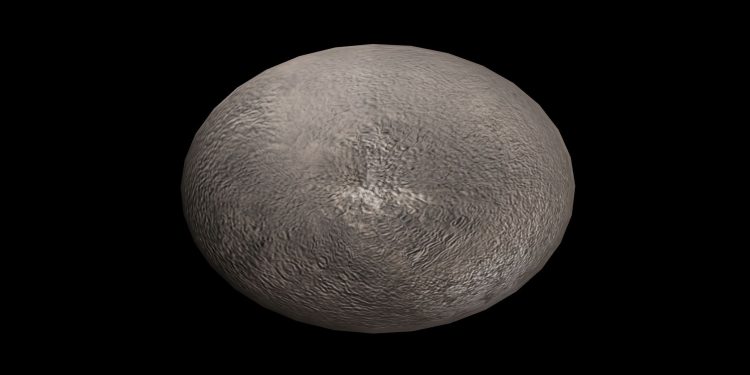NASA scientists have used computer simulations to figure out how the dwarf planet Haumea became one of the most unusual objects in our solar system. Haumea is located in the Kuiper Belt of icy worlds beyond Neptune’s orbit. Almost as large as Pluto, Haumea is a strange world in many respects. Unlike any other object of its size, it spins fastest, revolving on its axis in only four hours. Since Haumea spins so quickly, the planet is shaped more like a deflated football than a sphere. It has a surface largely composed of water ice, unlike almost any other object in the Kuiper Belt except for a dozen “siblings” with similar orbits, making up the only known “family” in the region.
How it came to be
NASA scientist Jessica Noviello wondered, “How did something so strange as this oddly shaped world come to be?”? Noviello and her colleagues turned to computer models to understand Haumea’s chemical and physical processes by tearing it apart and building it back up again. “In order to understand what happened to Haumea, we need to put time limits on everything that happened during the formation of our solar system, which ties everything together,” said Steve Desch, a professor of astrophysics at Arizona State University in Tempe, who collaborated with Noviello and others on the modeling experiment described in the Planetary Science Journal on Sept. 29.
A dwarf planet’s puzzle
Noviello worked in Desch’s lab from 2019 to 2020 as a research fellow. For several years, Desch had worked with his students to piece together disparate clues to uncover the story of Haumea’s evolution. “Haumea has a lot of weird, ‘gee-whiz’ parts,” Desch said, “and explaining them all is a challenge.” No satellite has yet visited the dwarf planet, so data is scarce because it is too far away to be measured precisely with an Earth-based telescope. For this reason, scientists rely on computer models to make predictions about Haumea (and other little-known worlds). In their initial model, the researchers fed Haumea’s estimated size and mass, along with its four-hour day rate, as the only three pieces of information.
Properties of a strange world
Haumea’s size, density, density, and core size, among other features, were predicted by the models. Using this information, Noviello created mathematical equations that calculated the volume of Haumea and the amount of ice on it. In addition, Haumea’s spin was calculated based on the distribution of mass on the planet. This information provided the basis for predicting how a baby Haumea would evolve into the mature dwarf planet it is today through the simulation of billions of years of evolution. “We wanted to understand Haumea fundamentally before poking back in time,” Noviello said. In order to account for family members who were once part of the dwarf planet, the scientists estimated it was 3% more massive. Assuming Haumea’s spin rate and volume might have been different, they also assumed it had a larger volume.
Models here, models there
By tweaking one of these features at a time in their model, they simulated how small changes in Haumea’s early years would affect its evolution. Scientists knew they had found the right story when the simulations produced results that looked like today’s Haumea. The model Noviello and her colleagues created suggests Haumea collided with another object when the planets first formed, and everything was zipping around the solar system. Even though the impact would have knocked off pieces, Noviello and her colleagues suggest those pieces do not correspond to the Haumean family we see today. Their theory is that such an impact would scatter Haumea bits in far greater numbers than its family members have.
The Haumean family
The Haumean family we see today came later. This was when the dwarf planet’s structure began to take shape: the center was settling dense, rocky material, while the surface was rising light ice. “When you concentrate all of the mass toward the axis, you decrease the moment of inertia, so Haumea spun even faster than it does today,” said Desch. The ice flung off the surface fast enough, scientists calculated, to create the Haumean family. According to NASA researcher Marc Neveu, Haumea’s rocks generated heat that melted ice below the surface, creating an ocean (no longer present) beneath the surface. A large clay core formed around Haumea when water soaked into the rocky material at its center, causing it to swell. As Haumea’s core grew larger, its moment of inertia increased and thus slowed its spin.
Have something to add? Visit Curiosmos on Facebook. Join the discussion in our mobile Telegram group.











